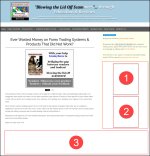- Home
- Technical Analysis
- Technical Analysis Tools Used in Forex Trading
Technical Analysis Tools Used in Forex Trading
by James Franklen
(freeforexoptions.com)
Traders, who incorporate technical analysis in their trading plan, use certain identifiable price patterns that are recorded on charts, or they use indicators that are computed from price actions that enable them to sense the future direction of the asset’s market price. Following are some of the technical analysis tools used in Forex trading.
Support and Resistance Levels
When you plan to trade in the Forex market, everyone tells you to follow a “buy low and sell high” approach in order to be successful in Forex trading, but what they often fail to realize is that it is not as easy as it sounds.
However, a technical analyst can identify the levels, at which the supply has been exhausted and higher prices are required to increase the supply, by carefully analyzing the price charts. He can also identify the levels where demand is completely satisfied, and prices are required to be decreased to generate more demand.
These levels are usually referred to as support and resistance levels, and are frequently used by Forex traders in interpreting price charts.
Counting Waves
In Forex trading, there is a well-known theory called Elliot wave theory. In this theory, repeating wave patterns are observed, and Fibonacci ratios are used to identify retracements and wave projection objectives. Generally, this theory suggests a five wave trending market, which is followed by three-wave corrective move.
Chart Patterns
Traders, who follow technical approach, usually follow exchange rate charts for currency pair trades. These charts are plotted over a period of time, and traders try to find the best patterns during their formation. The patterns include, head and shoulder tops and bottom, double tops and bottom, flags, triangles, wedges and pennants. Traders also try to find trading range, channels, and trends in these Forex charts.
The majority of these sophisticated chart patterns has anticipated value after these patterns break through a certain defined point and then define a “measured move”, which is considered a target for the succeeding price action.
Oscillators
Oscillator shows the price momentum, and the overbought/oversold condition in the market. This technical indicator is usually calculated on a scale of 0 to 100 percent. One of the most popular momentum oscillator is Stochastics Oscillator. The basic assumption behind this indicator is that in case of an uptrend, asset price usually close at the highest point of a range in one trading day to identify an upward moving momentum, whereas in case of a downturn, the price closes at a lowest point of a range to signify downward momentum.
Moving averages
Moving averages is another technical indicator used by Forex traders. It is calculated by taking an average of asset prices that fall within a particular period of time as it progresses over a range of time frames. There are three types of moving averages commonly used by traders, simple moving averages, weighted moving averages, and exponential moving averages.
The convergence and divergence of these moving averages produce signals, and you can accurately measure it with MACD (Moving Average Convergence Divergence) indicator.
RSI – Relative Strength Index
In case of an over-sold or over-bought market scenario, Relative Strength Index serves as a useful indicator. This indicator also moves on a scale of 0 to 100. For example, the Forex market is considered overbought if the Relative Strength Index is greater than 70, and oversold if it is lower than 30.
It is important for a trader to know what these technical analysis tools are and how they work, as it will be helpful to him when he incorporate these tools in his trading strategy.





